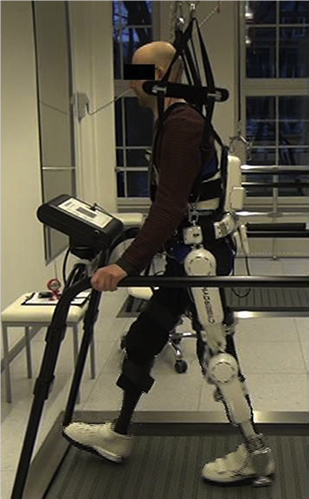Research Highlights
Vol.3, March 2015
Robotic supported training helps chronic spinal patients recover
Loss of strength and coordination may inhibit the mobility of spinal injury patients long after recovery in the nervous system is complete. An investigation by researchers in Germany and Japan has now demonstrated significant mobility improvements in spinal injury patients after training with the aid of a harness carrying a portion of their weight and a robotic hybrid assistive limb (HAL) exoskeleton designed by Cyberdyne, Inc., Japan.
Researchers from BG University Hospital Bergmannsheil in Germany and the University of Tsukuba in Japan monitored eight patients who had all reached a chronic state in their condition so that further improvement was unlikely. The training consisted of 90 minute physiotherapy sessions 5 times a week for 90 days. Each session included treadmill training using the HAL exoskeleton. Electrodes placed on the muscles monitor potential differences, allowing the HAL to read these muscle signals and respond with support from the motorised exoskeleton. In addition around 50% of the patients’ weight was supported by a harness to prevent toe dragging or knee buckling.
The researchers assessed the mobility of the patients using the time up and go (TUG) test, which measures the time and assistance required to stand up from a wheelchair, walk 3 m, turn around and walk back. They also monitored the speed and distance covered during treadmill training.
At the beginning of the study only three patients were able to walk for six minutes, whereas by the end all could. In addition speed, the distance covered, and the stride length during treadmill training increased and TUG times decreased.
“Hybrid assistive limb exoskeleton results in improved over-ground walking and leads to the assumption of a beneficial effect on ambulatory monility,” conclude the researchers in their report, adding. “Evaluation in larger clinical trials is required”.
Publication and Affiliation
Mirko Aach1*, Oliver Crucigera, Matthias Sczesny-Kaiser2, Oliver Höffken2, Renate Ch. Meindl1, Martin Tegenthoff2, Peter Schwenkreis2, Yoshiyuki Sankai3, Thomas A. Schildhauer4, Voluntary driven exoskeleton as a new tool for rehabilitation in chronic spinal cord injury: a pilot study. The Spine Journal 14 2847–2853, (2014).
- Department of Spinal Cord Injuries, BG University Hospital Bergmannsheil, Bürkle-de-la-Camp-Platz 1, 44797, Bochum, Germany
- Department of Neurology, BG University Hospital Bergmannsheil, Bürkle-de-la-Camp-Platz 1, 44797, Bochum, Germany
- Faculty of Engineering, Information and Systems, University of Tsukuba, 1-1-1 Tennodai, Tsukuba, Ibaraki 305-0006, Japan
- Department of General and Trauma Surgery, BG University Hospital Bergmannsheil, Bürkle-de-la-Camp-Platz 1, 44797, Bochum, Germany
*corresponding authors, e-mail address:bergmannsheil@bergmannsheil.de
Figure:







